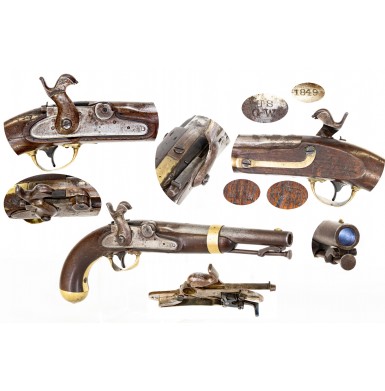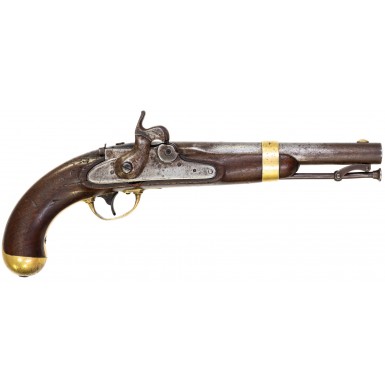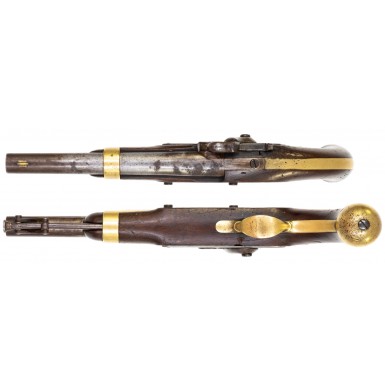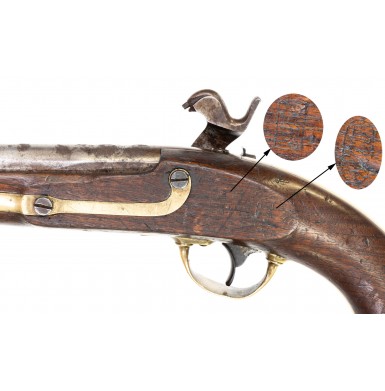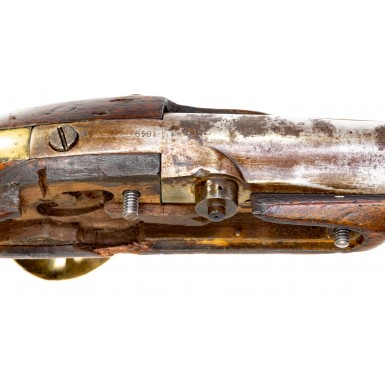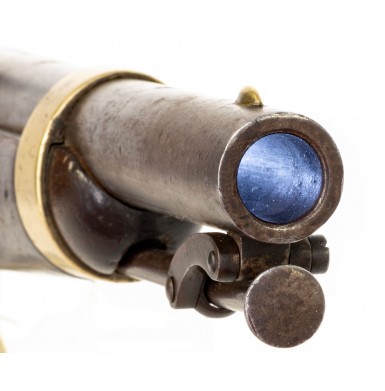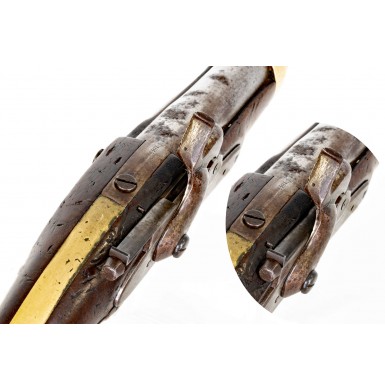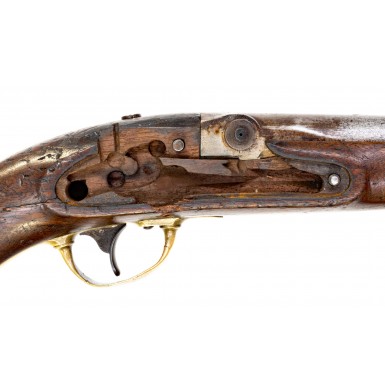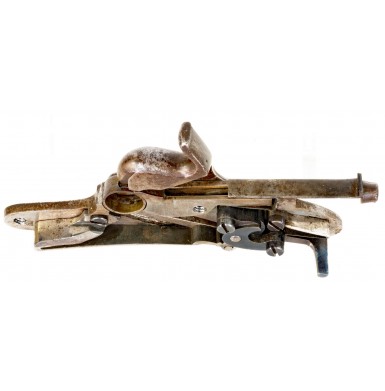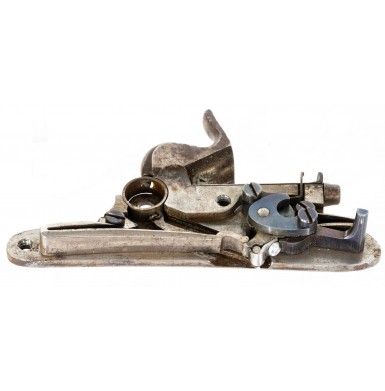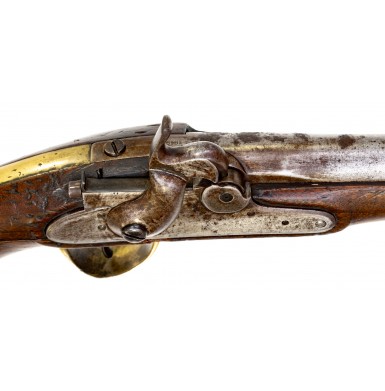Incredibly Rare Experimental Automated Priming System Built on a US Model 1842 Pistol
- Product Code: FHG-3494J
- Availability: Out Of Stock
-
$7,995.00
In 1845, Doctor Edward Maynard received a patent for an automatic priming system based upon a laminated paper roll that contained pellets of fulminate of mercury between the paper layers and which was varnished to provide a level of waterproofing. The roll of primers looked very similar to a modern roll of caps used in a child’s cap pistol. Dr. Maynard designed several mechanical feed systems all stored a roll of the primers in a magazine that was incorporated into the gun’s lock, and which fed a fresh primer onto the percussion cone (nipple) of the firearm as the hammer was cocked. A sharp cutting edge was designed into the lower lip of the hammer’s face, which would cut off the used piece of priming tape when the gun was fired. The US military first seriously considered the use of Dr. Maynard’s system circa 1847 and in February of 1848 the Ordnance Department contracted with Daniel Nippes to alter 1,000 US Model 1840 Muskets from flint to the Maynard system at the rate of $4.00 per gun. In November of the same year, the Ordnance Department contracted with Nippes to alter an additional 1,000 US Model 1840 muskets via the Maynard system, but this time the cost was only $3.00 per gun. As the US military was still utilizing smoothbore flintlock long arms for much of their line infantry at the time and was just beginning the transition to percussion smoothbore longarms with the adoption of the US Model 1842 musket, the experimentation with automated priming, particularly as a method of percussion alteration to flint, seemed to be somewhat logical at the time. At approximately the same time that the muskets were altered by Nippes it appears that a small number of US Model 1836 flintlock pistols were also altered by Nippes to the same Maynard priming system utilized on the muskets. Again, this seemed like a somewhat logical attempt to find a good way to upgrade the flintlock pistols to percussion with a system that also eliminated one of the steps in loading the guns.
Over the next few years, the Ordnance Department continued to flirt with the automated priming system concept. They had the 2,000 Nippes-Maynard altered muskets available for trials and they had begun to look at an improved version of the Maynard system for use on long arms. By 1855 the Ordnance Department had come to a licensing agreement with Dr. Maynard that allowed the incorporation of his system into the newly adopted US Model of 1855 family of small arms. The Maynard priming system would be used on the Model 1855 Rifle Musket, the Model 1855 Rifle, and the Model 1855 Pistol Carbine. Interestingly it would not be used with the 1855 Rifled Carbine, which would use a conventional percussion lock. Again, the concept seemed reasonable as it eliminated one of the steps in the multi-step process of loading a muzzleloading firearm. Interestingly the Ordnance Department appeared to have continued flirting with the concept for single shot handguns as well. This seems almost anachronistic in that as the metallic cartridge was being introduced to the world of firearms and because effective repeating percussion handguns were being brought to market. In fact, by the latter part of the 1850s the US military had already begun to acquire Colt percussion revolvers in some reasonable numbers for use by both the mounted services within the army and for the navy. A wonderful article on the subject of automatic priming systems applied to single shot percussion muzzleloading revolvers was authored by Richard “Dick” Salzer for the American Society of Arms Collectors Bulletin #106 and appears on pages 22-26.
Dick illustrates the better known automatic priming systems for single shot pistols, including the aforementioned Nippes-Maynard alteration on 1836 pistols and also mentions the occasionally encountered Gedney system and another by Jacob Rupertus. He also illustrates three variations of an automatic priming system that appears to be attributable to William Bell, who received three automated priming system patents in the 1850s, two of which were granted in 1859. In fact, the Gedney and Rupertus systems were also patented in 1859, which seems extremely strange as by that time it was clear that the percussion revolver was a very viable system and was certainly being acquired by the Ordnance Department in some quantities. Interestingly these experimental alterations, whether they be “tool room samples” or “proof of concept” models, are invariably built on US Modle 1842 Pistols. It is also worth noting that there must have been some reasonable US military prodding towards the creation of such as system as the article also shows a Springfield Armory altered 1842 Pistol with a newly fabricated, Springfield marked Maynard priming lock. This example appears to be dated 1846, so its manufacture is much more understandable than the guns that were being assembled on an experimental basis more than a decade later.
Offered here is one of those Incredibly Rare Experimental Automated Priming Systems Built on a US Model 1842 Pistol. Other than examples of this design in the collections of the late Ric Starbuck and formerly in the collection of Robert Sadler, it is not likely that more than two or three other extant specimens of this design exist. This design appears to be attributed to designer William Bell. Interestingly, Bell is not listed in Sellers but does appear in Stockel as working circa 1858-1860 in Washington, D.C. Stockel lists Bell as receiving US Patent #22,618 in 1859 for an automatic priming rifle and #27,518 in 1860 for an automatic priming revolver. At least three variations of the system incorporated into this gun exist and all are illustrated in Dick Salzar’s article.
The basics of the concept involve the use of loose fulminate of mercury which is loaded in a slotted rectangular horizontal magazine located along the inside of the neck of the percussion hammer and extending to the rear of the hammer. The loose fulminate was loaded into this channel and was moved by pushing on a removable plunger that was inserted into the channel. The plunger was retained by a small leaf spring that engaged a slot in the plunger and had to be depressed to remove the plunger, under normal circumstances. However, as Mr. Sadler points out, were the loose fulminate of mercury to detonate in the channel, it would propel the plunger like a rocket directly at the face of the person shooting the pistol! The standard percussion bolster was replaced with a drum shaped bolster with a small flash hole, rather than a cone seat and percussion cone. The modified lock included a drum-like sleave that surrounded the drum bolster, and which rotated with the action of the hammer. When the hammer was cocked the outer drum rotated towards the rear of the gun and took a round aperture with it. When the hammer was at full cock the aperture was aligned with the face of the priming channel and applying a small amount of pressure to the priming plunger would push some fulminate into the aperture. When the trigger was pulled the hammer fell and the modified mechanism would rotate the drum forward as well, aligning the aperture with the touchhole in the bolster and the hammer nose. When the nose struck the fulminate, it would ignite, and the flash would pass through the touchhole into the firing chamber of the pistol. The rather complicated system required the shooter to manipulate the firing mechanism with some degree of dexterity and appears to be much more prone to being mishandled or accidently misfiring than simply placing a conventional percussion cap on a percussion cone (nipple). An honest cost benefit analysis of the system would clearly indicate that the complicated mechanical modifications combined with the equally complicated manipulation of the system in order for it to fire reliably, offered no legitimate advantages over a standard percussion ignition pistol. When considered against the fact that several thousand Colt percussion revolvers had been acquired by the US military by this time, the system seems even more eccentric and poorly considered.
This Incredibly Rare Experimental Automated Priming Systems Built on a US Model 1842 Pistol remains in about GOOD+ to NEAR VERY GOOD condition. In all ways, with the exception of the modifications to the lock, lock mortise, bolster, and hammer to make the Bell priming system functional, the gun remains a standard US Model 1842 contract pistol made by Aston. While the lock markings were obliterated by the machining and modification of the lock, the barrel markings remain legible and the barrel’ sub-inspector reveal that this was an Aston contract pistol. The breech is still clearly marked US/GW with the tang dated 1849. The inspection initials are those of George Wright who was an Ordnance Department civilian inspector. The counterpane of the pistol is struck with two scrip cartouches, the forward one appears to be the JPC of arsenal sub-inspector James P Chapman and the rearmost cartouche is the WAT of Ordnance Officer William Anderson Thornton.
The pistol shows moderate wear and appears to have suffered from poor storage. As noted, the lock markings were machined away during the modification process, but the barrel markings remain clear, and the cartouches are at least partially legible. The metal of the smoothbore barrel has a medium pewter patina with scattered surface oxidation and discoloration and freckles of darkness here and there. The barrel shows scattered patches of moderately oxidized surface roughness and some patches of old rust along with some scattered pitting. The brass furniture has a medium golden patina. The lock remains mechanically functional, as does the automated priming system. Two small pieces of the priming mechanism are modern replacements. The first is a small piece of metal that secures the operating arm of the rotating drum to the tumbler so that it rotates when the hammer moves, and the screw that secures that tiny piece of metal to the tumbler. Otherwise, the lock and the balance of the gun are 100% original and correct. The smooth bore of the pistol remains in VERY GOOD condition with moderate amounts of scattered oxidation and discoloration, with some scattered pitting. The stock of the pistol rates about GOOD+ and shows moderate wear and numerous handling marks, bumps, and dings. There is a small amount of wood that has been relieved along the lower edge of the lock mortise. This relieved wood appears like a small half circle of wood missing below the lower edge of the lock at its center. The relief is necessary for the operating arm mechanism that moves the rotating drum to function correctly. The two other examples of these pistols that I have seen both have this same relieved area, so it is not damage, but part of the modification. The wood shows a tight grain crack at the tail of the lock mortise, extending towards the grip and a tiny grain crack running from the rear lock mounting screw to the barrel channel. Both are old, tight cracks and do not appear to be structural. As noted, the stock does show a large number of bumps, dings, and mars, much of which may be the result of poor storage, much like the oxidation on the barrel.
Overall, despite the somewhat salty appearance, this is really a GOOD+ to NEAR VERY GOOD example of an Incredibly Rare Experimental Automated Priming System Built on a US Model 1842 Pistol. I know of only three extant examples of this gun, and it appears realistic to believe that less than five exist. How many were ever produced may not be known, but the fact that three survive suggests that 1) these were more than just “proof of concept” guns and were probably at least produced as samples for some sort of trials and 2) a realistic estimate would be that between ten and twenty were likely built for at least three to survive. For the students and collectors of firearms curiosa, this is a wonderful piece to add to your collection. Likewise for the collector of experimental and trial arms this is a must have piece for your collection. Whether your interest is in the evolution of firearms mechanisms or 19th century US military arms development, this is one of those incredibly unique pieces that will always be a conversation starter and which you know will be one that none of your collecting friends will have in their collection as well!
SOLD
Tags: Incredibly, Rare, Experimental, Automated, Priming, System, Built, on, a, US, Model, 1842, Pistol

